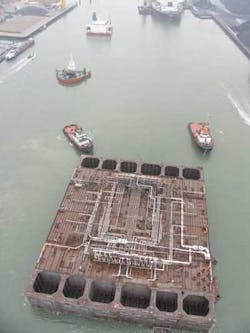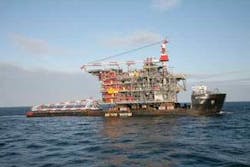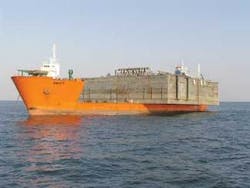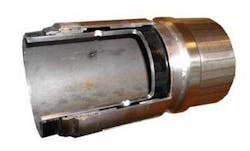Petro-Canada positioning De Ruyter as potential Dutch oilfield hub
Jeremy Beckman, Editor, Europe
Oilfield activity has revived offshore The Netherlands, driven exclusively by Petro-Canada. De Ruyter, the company’s first operated new development in the sector, progresses towards start-up this fall. At peak, it should add around 27,000 b/d gross to Dutch North Sea oil production.
Some of its more striking engineering features have been derived from Hanze, the only other new Dutch oilfield project of the past decade. These include a gravity storage base supporting the steel platform, with oil discharged a short distance via a tanker mooring and loading system.
Petro-Canada took control of Hanze - developed originally by Veba Oil & Gas - in 2002, following a Cdn $3.2 billion transaction with BP. The full package comprised exploration and production interests across three continents amassed by Veba, which BP had acquired in 2001 from EON during its expansionist phase.
Reidar Hustoft was brought to Aberdeen that year to manage UK operations for Veba Oil and Gas. Two years later, he was on his way to The Hague as Petro-Canada’s new country manager. “My brief was to grow the organization in The Netherlands,” he says. “The company had already started this process at the end of 2002, launching conceptual studies for De Ruyter.”
The field is in 30-35 m of water, 60 km northwest of The Hague, on the border of shelf features known as the Bruine Bank and the Breeveertien. It was discovered by Amoco during 1996-97, in partnership with Veba, via two exploratory wells on block P11b. “They had been looking more for gas,” Hustoft points out, “but finding oil in a Triassic interval was something new on the Dutch shelf.” Later analysis also proved an extension of the structure into block P10.
Early conceptual work and development studies were halted in 1999, when the oil price tumbled to a record low. At that point, De Ruyter was viewed as sub-economic, and remained inactive until Petro-Canada took the reins following its acquisition of Veba.
The new operator also viewed this as a marginal project, with an oil price at the time of $20-30. “But we still felt confident about development, he says.”
During its re-evaluation process, Petro-Canada performed additional mapping over the two De Ruyter discovery locations, and reprocessed old 3D seismic that covered the whole of block P11b. A more detailed picture emerged of an oil and gas accumulation in a Permian rock formation, concentrated in Volpriehausen and Hewett/Fringe sandstones. The team also identified nearby structures that might warrant further exploration.
One of the discovery wells had intersected a thick oil column, the other encountering a gas cap. “For the development, that gas cap presented an extra challenge,” Hustoft says, “but we had had recent experience of these conditions in the UK North Sea, developing the Guillemot West, Guillemot Northwest and Pict reservoirs. The key issue for the eastern reservoir of De Ruyter, we felt, would be accurate placement of a multilateral horizontal well between the oil/water and gas/water contacts.”
Screening issues
In February 2003, the company applied for a production license for block P11b. Around the same time, Amec in the UK was contracted for front-end engineering for the platform. Fourteen months later, in April 2004, the Dutch Ministry of Economic Affairs issued formal approval both for the license and the proposed €300-million development, in partnership with state-owned Dutch energy utility EBN.
Petro-Canada screened alternative production concepts, including a converted jackup, and fixed and floating platforms. But development and operating costs, the project schedule, and oil and gas export options all swayed the decision in favor of a Hanze ’look-alike’ - in this case, a wellhead/production platform fixed to a 150,000 bbl capacity steel storage base by a 40-m tall steel lattice tower and a 60-m wellhead tower. Production would be offloaded periodically to shuttle tankers.
“Hanze had been very successful,” Hustoft explains, “and that gave us confidence to go for this option. The design of De Ruyter’s GBS [gravity base structure] is not that different from Hanze’s, although its surface area is larger due to the different seabed conditions.”
There were concerns that sand quality in the top layer at the planned location would be unstable during severe storms. Numerical simulations of sediment stability, followed by model tests at Oceanide in southern France, eventually led to selection of a modified foundation design, with extra weight added to the structure, and a special protective rock material around the base. The additional engineering and design work pushed De Ruyter’s targeted start-up date six months to late 2006.
Based on its assessment of the field’s reserves (not disclosed), Petro-Canada foresees productive facility life of six to eight years. In the event of future discoveries in the area, the platform also will serve as a processing hub. With this in mind, space was left to tie in future risers, with five spare well slots in addition to the three in use.
As at Hanze, De Ruyter’s produced oil will head through a 16-in. diameter, 1.5-km steel pipeline to the base of a 250-ton tanker mooring loading system (TMLS) on the seabed, supplied by APL. On arrival, the shuttle tanker locates and hooks to a 16-in. diameter flexible loading hose manufactured by Trelleborg, also connected to the base.
“During the early stages of production,” Hustoft says, “we will employ a newly converted bow loading, DP2-class, 35,000-dwt dedicated shuttle tanker, theGijon Knutsen. The tanker will be equipped with a system to minimize emissions of volatile organic compounds (VOCs) during crude loading and transportation.
“As De Ruyter comes off plateau, we may end up using the same vessel for both fields.” This would be either theGijon Knutsen or the 250,000 bbl capacity bow loading tanker Betty Knutsen I that has been in service every five days on Hanze since start-up in 2001.
“We have had very good experience with that arrangement. As on Hanze, De Ruyter’s crude will be stabilized prior to loading into the tanker, but in this case, the process is simpler, and the stabilization column in service on Hanze is not required.”
Associated gas will be sent for treatment at 22 MMcf/d to Wintershall’s P12 South West platform through an 8-in., 29-km pipeline, and onward to the P6A platform, before heading to the Dutch mainland via the NGT trunkline. Both De Ruyter pipelines were installed last summer by Allseas’Solitaire.
GlobalSantaFe’s jackupGSF Labrador, secured on a long-term contract early last year, arrived on location in July to start the first of three development wells. Of these, two are classified as “sub-horizontal” producers. “One of them will be very high angle, but not completely horizontal,” Hustoft explains, “to ensure the wellbore trajectory intersects all the reservoir layers. The third - horizontal - producer will be a multilateral.”
All the wells will incorporate electric submersible pump (ESP) completions designed and supplied by Centrilift. Reservoir models suggested ESPs would provide the optimum lift solution, unlike Hanze, which is supported by water injection. “We believe the reliability problems associated with ESPs have been overcome, and the newer versions are achieving very long run times.
“In De Ruyter’s case, there appears to be good pressure support from the aquifer, so we don’t expect the ESPs to be needed during the first year of production. Over the longer term, they will help us to increase recovery, especially if we decide to tie in future satellite discoveries.” With this in mind, theGSF Labrador I is booked for two exploration wells on nearby structures on completion of development drilling. “Again, we have a lot of experience in the UK sector tying in satellite discoveries and bringing them on stream quickly.”
De Ruyter’s wells have been designed by Petro-Canada, with the help of service providers and consults. The completions feature special sand screens supplied by Norwegian contractor ResLink, with zonal isolation and inflow control devices to ensure more even pressure drawdown and production across the well paths.
“We have configured the wells for optimum recovery,” Hustoft says. “We have not gone for the cheapest completion, although there are no moving parts downhole other than the ESPs. All the equipment selected is well proven.”
Fabrication control
Main fabrication contracts were put out to worldwide tender. Hyundai, which had assembled Hanze’s gravity base, was again a contender for De Ruyter’s GBS. In the event, Heerema picked up the combined construction/transportation contract for both the base and the 5,300-metric ton integrated production deck. “We wanted Heerema to take on all responsibilities for fabrication drawings - they were happy to gain control of the project,” Hustoft claims.
The three-level 4,900 sq m deck, including accommodation for 33 personnel, sailed out of the company’s yard in Zwijndrecht in The Netherlands early in June, and was installed offshore on June 23. Hereema’s other main yard, in Vlissingen, south of Rotterdam, assembled the wellhead tower (built into the base structure), and the lattice structure supporting the deck. These were recently integrated with the 66 x 73 m GBS, fabricated by Dubai Dry Dock under subcontract. The latter had been transported to Vlissingen onboard the Dockwise vesselSwift.
Prior to tow-out to the field, the GBS was stabilized with 25,000 tons of orecrete ballast and 6,000 tons of concrete. As a preparatory measure, the seabed/soil was removed to a depth of 5 m in the vicinity of the GBS, ahead of its installation by Smit Marine Contractors. Post-installation, Boskalis, using the rockdumping vesselSandpiper, set down over 130,000 metric tons of high density rock brought in from Norway.
SPT Offshore completed installation of the TLMS suction base this May, working under subcontract to Smit. According to SPT’s Mark Riemers, “the TLMS, located around 2 km from the GBS, is the subsea oil offloading point, holding the subsea turret system and the attached offloading hose for connection to the shuttle tanker.
“The TLMS is founded on a base of four clustered suction piles. SPT provided a single suction pump spread and crew to install the base, which was effected in medium-dense to dense sands to the target penetration depth of 5.3 m. Our suction operation lasted seven hours and the maximum suction pressure was 150 kPa (1.5 bar).”
In August, all offshore installations and tie-ins should be completed, with first stage hook-up under way. First oil should be delivered on time and within budget. “Like the rest of the industry, we’re facing a drive to reduce cost pressures,” Hustoft says. “It’s a very tight market for equipment, with the costs for all types of services and personnel also increasing significantly. But so far on this project, we have managed to control these increases.”
Inflow control device stems water/gas breakthrough
The De Ruyter field consists of two oil accumulations: one structure is being developed with two long horizontal wells in the Hewett & Zechsten-Fringe formations, while the second structure has a thin oil rim below an active gas cap in the Volpriehausen formation. This is being developed with a multi-lateral well.
Petro-Canada sought a completion technology that could defer both early water breakthrough in the high permeable layers in the Hewett & Zechsten-Fringe and early gas breakthrough in the Volpriehausen formation.
ResFlow, Reslink’s nozzle-based Inflow Control Device (ICD) technology, was selected to optimize production in De Ruyter since it provides a mitigation to the above challenges without the use of expensive and complicated intelligent well completion technologies. There are no movable parts or control lines to surface in this simple, robust and reliable sand and flow control system.
Fluid enters the system’s direct wrapped screens, but instead of passing into the tubing through perforation holes, it flows between the screen jacket and base pipe into the housing, entering the production tubing through the nozzles. The result is a pressure drop between the sand face and the tubing.
The pressure drops through the nozzles are controlled by the Bernoulli pressure drop equation, which is independent of the fluids viscosity but heavily dependent on the fluid velocity squared and fluid density. In a reservoir the pressure drop is controlled by Darcy flow equation, which is dependent on the viscosity of the fluids, permeability, and the velocity only in first order.
The nozzle-based ICD completions should achieve a more uniform inflow profile along the well, allowing higher oil recovery from lower quality reservoir zones, and delaying unwanted gas or water breakthrough. In addition, if such a breakthrough eventually occurs, the system will restrict the inflow compared to a standard open-hole completion system.
Two reservoir simulation software packages, NETool and Eclipse, were used for targeting and design in the nozzle configuration for De Ruyter’s wells. Incremental oil recovery and delayed and reduced water cut were the result of the different sensitivity simulations performed.




